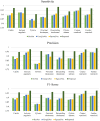Deep learning-based anatomical position recognition for gastroscopic examination
- PMID: 38669495
- PMCID: PMC11191429
- DOI: 10.3233/THC-248004
Deep learning-based anatomical position recognition for gastroscopic examination
Abstract
Background: The gastroscopic examination is a preferred method for the detection of upper gastrointestinal lesions. However, gastroscopic examination has high requirements for doctors, especially for the strict position and quantity of the archived images. These requirements are challenging for the education and training of junior doctors.
Objective: The purpose of this study is to use deep learning to develop automatic position recognition technology for gastroscopic examination.
Methods: A total of 17182 gastroscopic images in eight anatomical position categories are collected. Convolutional neural network model MogaNet is used to identify all the anatomical positions of the stomach for gastroscopic examination The performance of four models is evaluated by sensitivity, precision, and F1 score.
Results: The average sensitivity of the method proposed is 0.963, which is 0.074, 0.066 and 0.065 higher than ResNet, GoogleNet and SqueezeNet, respectively. The average precision of the method proposed is 0.964, which is 0.072, 0.067 and 0.068 higher than ResNet, GoogleNet, and SqueezeNet, respectively. And the average F1-Score of the method proposed is 0.964, which is 0.074, 0.067 and 0.067 higher than ResNet, GoogleNet, and SqueezeNet, respectively. The results of the t-test show that the method proposed is significantly different from other methods (p< 0.05).
Conclusion: The method proposed exhibits the best performance for anatomical positions recognition. And the method proposed can help junior doctors meet the requirements of completeness of gastroscopic examination and the number and position of archived images quickly.
Keywords: Gastroscopic image; anatomical position recognition; convolutional neural network.
Conflict of interest statement
None to report.
Figures
Similar articles
-
A deep learning approach for gastroscopic manifestation recognition based on Kyoto Gastritis Score.Ann Med. 2024 Dec;56(1):2418963. doi: 10.1080/07853890.2024.2418963. Epub 2024 Nov 5. Ann Med. 2024. PMID: 39498518 Free PMC article.
-
Classification of precancerous lesions based on fusion of multiple hierarchical features.Comput Methods Programs Biomed. 2023 Feb;229:107301. doi: 10.1016/j.cmpb.2022.107301. Epub 2022 Dec 6. Comput Methods Programs Biomed. 2023. PMID: 36516661
-
Application of Imaging Examination Based on Deep Learning in the Diagnosis of Viral Senile Pneumonia.Contrast Media Mol Imaging. 2022 May 31;2022:6964283. doi: 10.1155/2022/6964283. eCollection 2022. Contrast Media Mol Imaging. 2022. PMID: 35694707 Free PMC article.
-
Early gastric cancer segmentation in gastroscopic images using a co-spatial attention and channel attention based triple-branch ResUnet.Comput Methods Programs Biomed. 2023 Apr;231:107397. doi: 10.1016/j.cmpb.2023.107397. Epub 2023 Feb 3. Comput Methods Programs Biomed. 2023. PMID: 36753915
-
Deep learning for gastroscopic images: computer-aided techniques for clinicians.Biomed Eng Online. 2022 Feb 11;21(1):12. doi: 10.1186/s12938-022-00979-8. Biomed Eng Online. 2022. PMID: 35148764 Free PMC article. Review.
References
-
- Park J, Herrero R. Recent progress in gastric cancer prevention. Best Practice & Research Clinical Gastroenterology. 2021; 50: 101733. - PubMed
-
- Gulati S, Patel M, Emmanuel A, Haji A, Hayee B, Neumann H. The future of endoscopy: Advances in endoscopic image innovations. Digestive Endoscopy. 2020; 32(4): 512-522. - PubMed
-
- East J, Vleugele J, Roelandt P, Bhandari P, Bisschops R, Dekker E, et al. Advanced endoscopic imaging: European society of gastrointestinal endoscopy (ESGE) technology review. Endoscopy. 2016; 48(11): 1029-1045. - PubMed
-
- Ponsky J, Strong A. A history of flexible gastrointestinal endoscopy. Surgical Clinics of North America. 2020; 100(6): 971. - PubMed
MeSH terms
LinkOut - more resources
Full Text Sources




